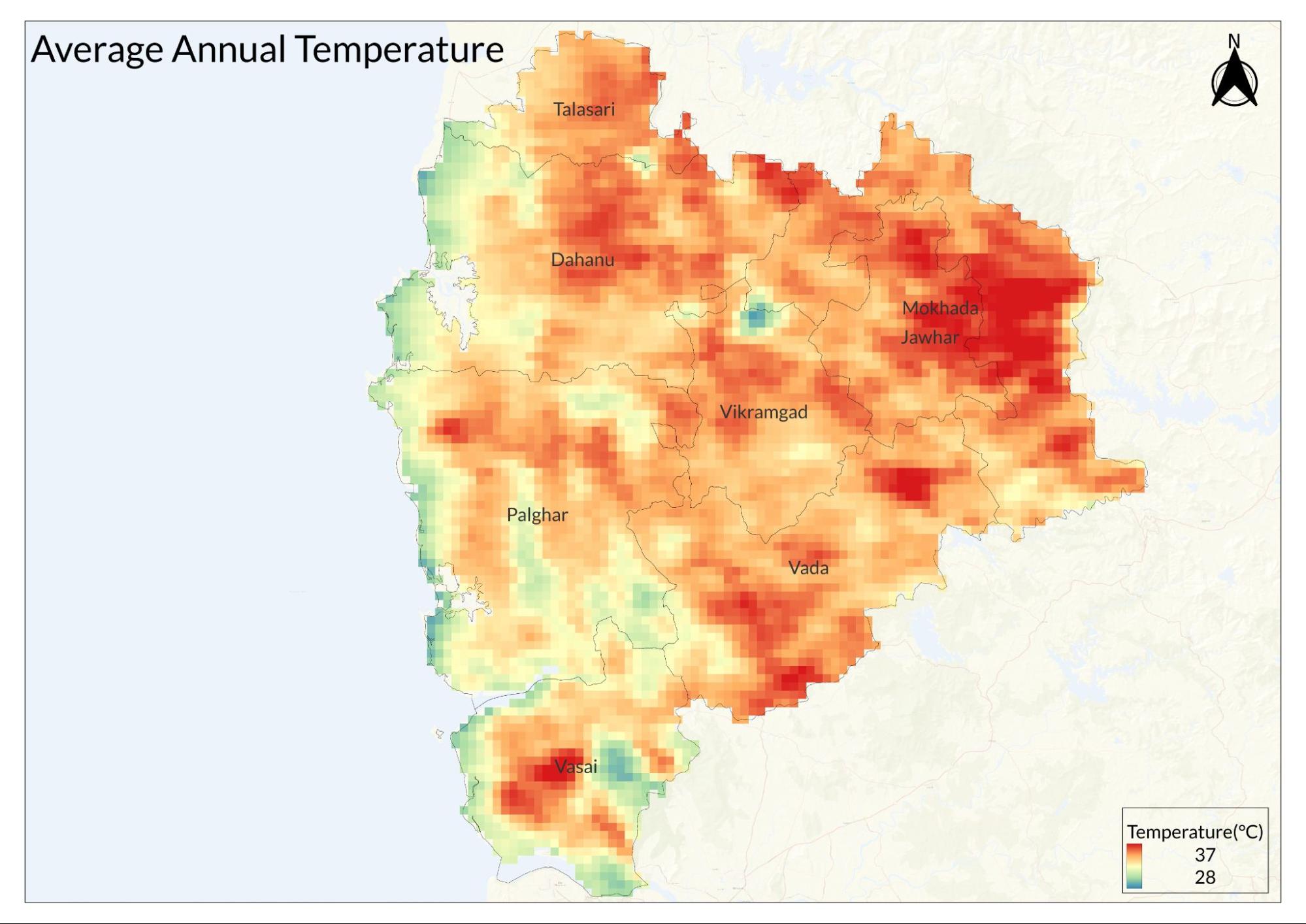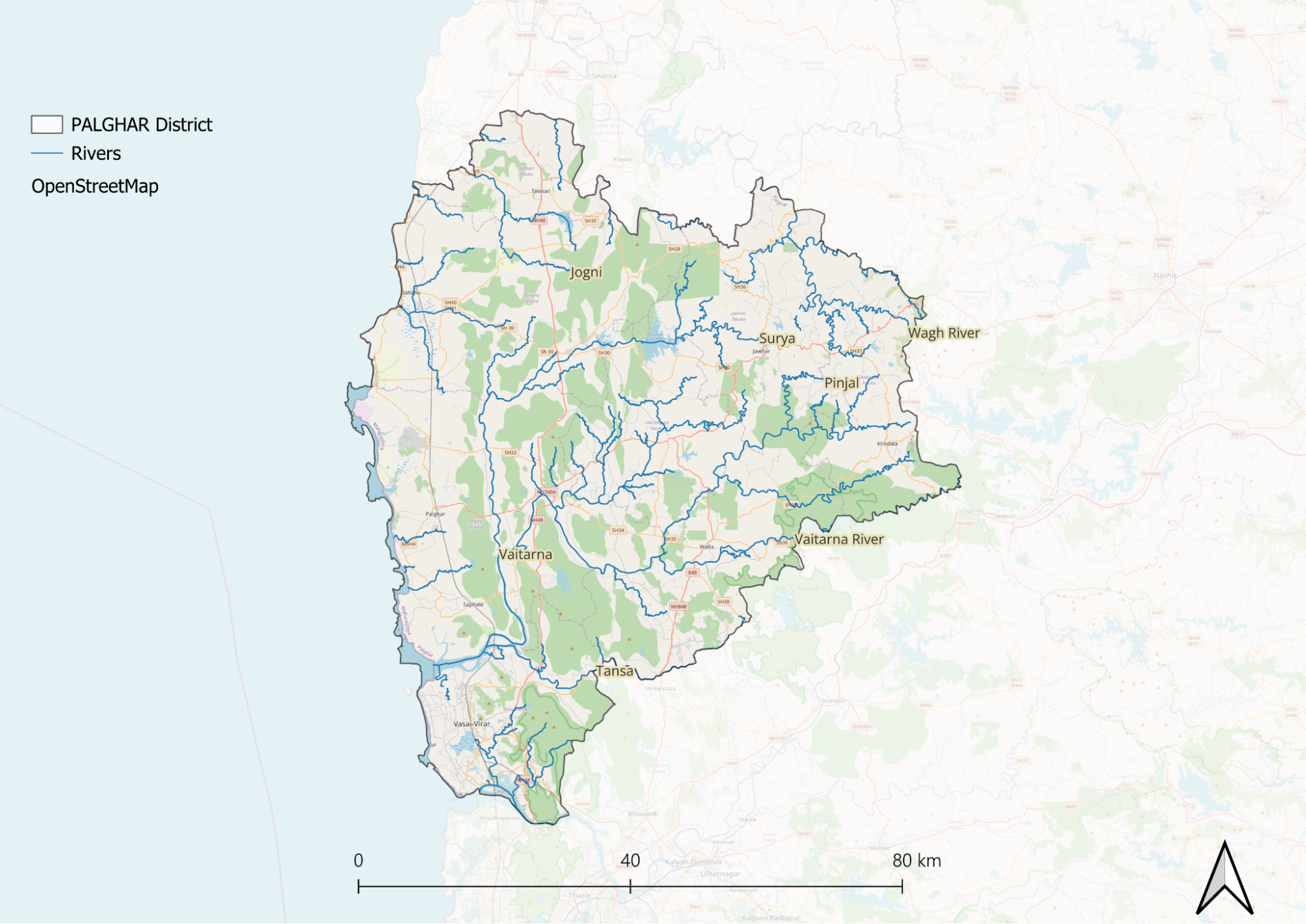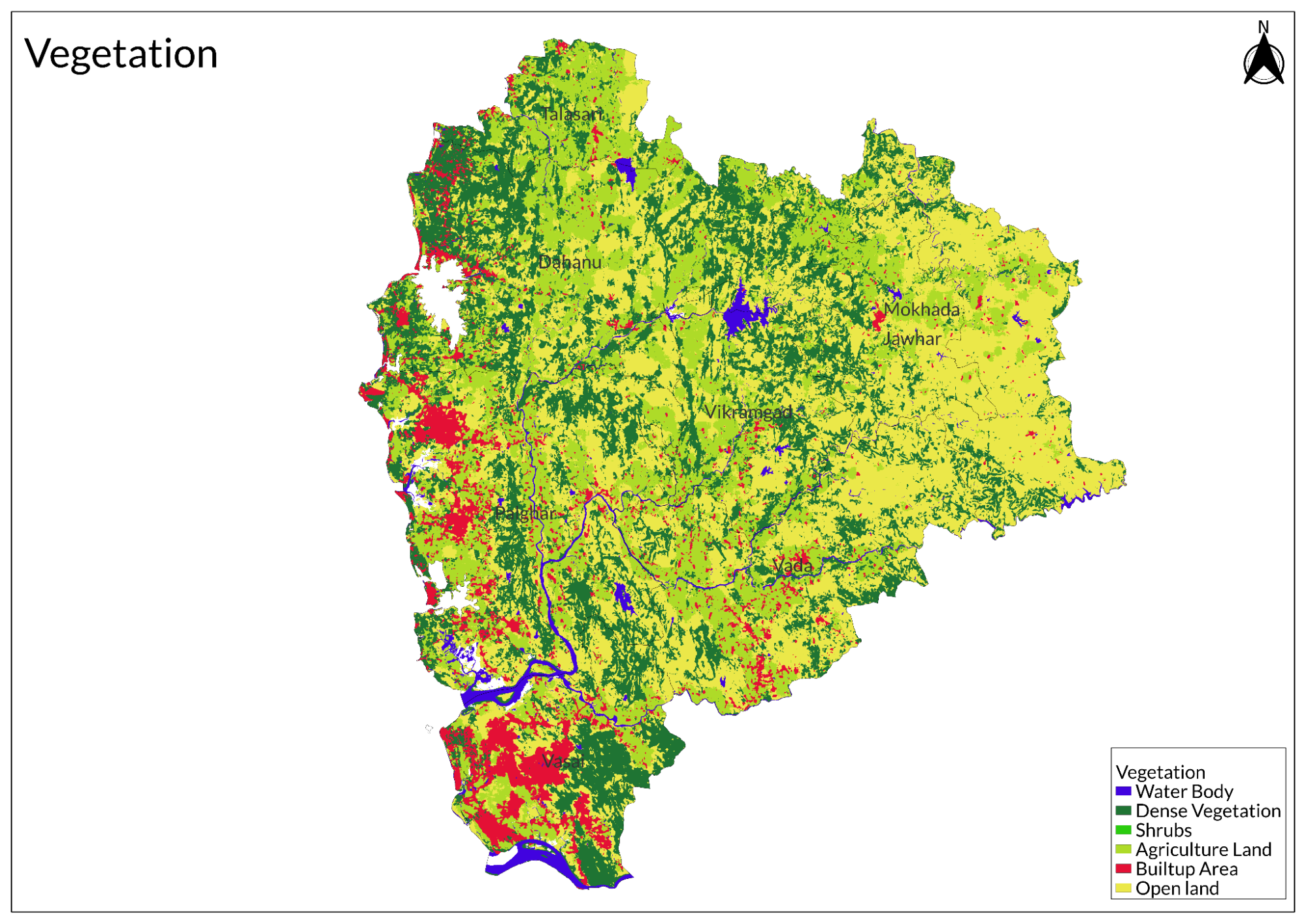Contents
- Physical Features
- Climate
- Geology
- Soil
- Rivers
- Botany
- Forest Reserves
- Tungareshwar Wildlife Sanctuary
- Land Use
- Environmental Concerns
- Deforestation
- Marine and Coastal Pollution
- Illegal Sand Mining
- Industrial Pollution
- Vadhava Port Protests
- Paaneri river Protests
- Navghar Village
- Graphs
- Water
- A. Rainfall (Yearly)
- B. Rainfall (Monthly)
- C. No. of Rainy Days in the Year (Taluka-wise)
- D. Evapotranspiration Potential vs Actual Numbers (Yearly)
- E. Annual Runoff
- F. Runoff (Monthly)
- G. Water Deficit (Yearly)
- H. Water Deficit (Monthly)
- I. Soil Moisture (Yearly)
- Climate & Atmosphere
- A. Maximum Temperature (Yearly)
- B. Maximum Temperature (Monthly)
- C. Minimum Temperature (Yearly)
- D. Minimum Temperature (Monthly)
- E. Wind Speed (Yearly)
- F. Wind Speed (Monthly)
- G. Relative Humidity
- Forests & Ecology
- A. Forest Area
- B. Forest Area (Filter by Density)
- C. Wildlife Projects (Area and Expenses)
- Human Footprint
- A. Nighttime Lights
- Sources
PALGHAR
Environment
Last updated on 6 November 2025. Help us improve the information on this page by clicking on suggest edits or writing to us.
Physical Features
Palghar district lies between 19°17'N to 20°14'N latitude and 72°39'E to 73°30'E longitude in Maharashtra. The Arabian Sea borders it on the west, Thane district to the south, Nashik district to the east, and Gujarat to the north. The district has four distinct geographical zones. The Coastal Zone stretches 112 kilometers along the Arabian Sea, featuring beaches, rocky outcrops, and creeks. Coastal plains extend 10-15 kilometers inland with mudflats and tidal marshes.
The Western Foothills rise from 50-200 meters above sea level, characterized by rolling hills and lateritic plateaus. Small valleys and drainage channels cut through this terrain. The Central Highland Zone reaches elevations of 300-500 meters, marked by steep slopes and deep valleys. Local watersheds form here, creating springs and streams that support local communities. The Eastern Plateau Region averages 400 meters in elevation with gentler terrain. Broader valleys with fertile soil make this zone suitable for agriculture. Terraced farming is common here, taking advantage of the natural slopes.
Rivers like the Vaitarna flow westward through the district in a dendritic pattern. These rivers shape the landscape and support settlements along their banks. Settlement patterns reflect the terrain: coastal towns in the west, agricultural communities in the valleys, and tribal settlements in the hills. Transportation routes typically follow natural valleys and pass through the region.
Climate

The region experiences three main seasons: summer, monsoon, and winter. Temperatures vary seasonally, with summer (March-May) reaching 25°C to 35°C. The monsoon period (June-September) sees moderate temperatures of 23°C to 30°C. Winters (November-February) are pleasant with temperatures between 15°C to 28°C. May records the highest temperatures, while January is the coolest. Annual rainfall averages 2000-2500mm, with 80% occurring during the southwest monsoon from June to September. May sees occasional pre-monsoon showers, while October has some post-monsoon rainfall.

Humidity remains high throughout the year. Coastal areas experience 70-90% humidity, while inland regions see 60-80%. Levels peak during monsoon months and are lowest in winter. Mornings are typically more humid than afternoons. Wind patterns follow seasonal changes. Southwest monsoon winds dominate June-September, bringing heavy rainfall. Winter sees northeast winds. Coastal areas benefit from sea breezes, with stronger winds during the monsoon and calmer conditions in winter.
Geology

The region features various rock formations, including lateritic formations, alluvial deposits, marine sediments along the coast, and isolated metamorphic rocks.
The geological timeline includes the Upper Cretaceous to Lower Eocene period when the Deccan Trap was formed, followed by the Quaternary period with alluvial and coastal deposits. Recent times have seen ongoing weathering and soil formation. Structural features such as horizontal lava flows, columnar jointing in basalts, fault lines, and coastal geomorphology highlight the area's volcanic activity and geological processes. Palghar is divided into two main geological zones: the Coastal Zone, which includes marine sediments and beach deposits, and the Inland Zone, characterized by basaltic plateaus and river valleys. Economically, the region supports activities like building stone quarries, basalt mining, sand extraction, and groundwater aquifers, all of which influence soil formation, drainage patterns, and land use.
Soil

The main types of soils include Vertisols (black soils) and red soils. Vertisols have high clay content, allowing for good moisture retention, making them ideal for cotton cultivation. In contrast, red soils, found in hilly areas, are typically acidic (pH 5.86 to 7.08) and require additional fertilization due to lower nutrient retention.
Coastal alluvial soils are affected by tidal actions and can be saline, which poses challenges for growing sensitive crops. Additionally, lateritic soils, prevalent in high-rainfall areas, are rich in iron but can be shallow and less fertile without proper management. Soil health is crucial for agricultural productivity in Palghar. Salinity from industrial activities and varying organic carbon levels (averaging 4.22 to 11.11 g/kg) affect soil fertility. The region supports crops like rice and chickoo (sapota), but sustainable farming practices are needed to address challenges like salinity and nutrient deficiencies.
Rivers

The Vaitarna is the main river in the district, with key tributaries including Barvi, Bhatsa, Pinjal, Surya, Daherja, and Tansa. It is the largest river in the Konkan region, originating in the Trimbakeshwar hills of Nashik district, near the Godavari's source. The river flows through Shahapur, Vada, and Palghar talukas before entering the Arabian Sea through a wide estuary near Arnala. The Vaitarna is 154 km long and drains most of the northern part of the district. The Ulhas River flows into Vasai Creek, marking the district's southern border. Arnala Island is located in Vasai taluka at the Vaitarna estuary's entrance.
Botany
The local tribes, such as the Warli and Katkari, incorporate these plants into their diets and traditional practices, often using them in various culinary preparations like pickles and jams. Some notable species include Ambadi, whose flower buds are used in salads and cooked dishes, and Abai, with pods consumed as vegetables. Ajola provides young leaves and flowers for cooking, while Bhovara offers fruits that can be eaten raw.
Other important plants include Kawlu, which has young leaves used as vegetables, and Kakd, known for its edible fruits. Kantorla yields fruits that are typically eaten fresh, while Koral provides young leaves and shoots for culinary use. Additionally, Suran features rhizomes that are consumed as food, and Takala offers leaves used as greens.
Forest Reserves
Tungareshwar Wildlife Sanctuary
Wild animals in Palghar district include a variety of species, particularly within the Tungareshwar Wildlife Sanctuary. This sanctuary serves as a critical habitat for numerous wildlife species and acts as a corridor connecting Sanjay Gandhi National Park and Tansa Wildlife Sanctuary. Recent reports highlight concerns about leopard sightings in the area, particularly around Saphale, where a calf was reportedly killed by a leopard, indicating that these big cats are venturing closer to human settlements in search of food. The sanctuary is home to diverse fauna, including leopards, wild boars, and various bird species.
Encroachments and unauthorized constructions within Tungareshwar Wildlife Sanctuary have raised alarms among conservationists, as they disrupt the natural habitat and force wildlife to stray into human-inhabited areas in search of food and water. Studies have documented a rich avifauna in the Waghoba forest, with over 77 species of birds recorded, showcasing the biodiversity of the region.
Land Use

Environmental Concerns
Deforestation
Palghar district, Maharashtra, lost 87 square kilometers of forest cover, the highest in the state, according to the India State of Forests Report (ISFR) 2023. In 2020, the district had approximately 108 square kilometers of natural forest, covering over 20% of its land area. Deforestation has led to biodiversity loss, with various plant and animal species declining due to habitat destruction. Key drivers include over-exploitation of forest resources, agricultural expansion, infrastructure development, and climate change, disrupting local ecosystems and ecological balance.
Marine and Coastal Pollution
Coastal and marine pollution in Palghar district, Maharashtra, has led to significant environmental and economic impacts. In 2020, the National Green Tribunal (NGT) ordered 102 industrial units and the common effluent treatment plant in Tarapur, Maharashtra Industrial Development Corporation (MIDC), to pay ₹160 crore for environmental restoration, including ₹75 crore as a ‘Super Fund,’ due to untreated effluent discharge into drains, creeks, and the sea. This pollution has affected 18 fishing villages from Tarapur to Kelve, leading to declines in fish populations. In 2016, the Akhil Bhartiya Mangela Samaj Parishad reported dead fish washing ashore, prompting the NGT to assign an expert committee to assess damage. Additionally, Palghar’s coastal areas, including Kelwe, Thembi, and Vadrai beaches, have been impacted by tarballs, which are weathered petroleum deposits affecting fish reproduction and posing health risks. The Maharashtra Pollution Control Board (MPCB) has conducted site visits and sample analyses, but a comprehensive cleanup strategy remains absent, leading local residents to organize independent cleanup drives.
Illegal Sand Mining
Illegal sand mining around Julie Island near Vaitarna Creek in Palghar district has led to environmental degradation and infrastructure risks. The Bombay High Court directed the Maharashtra government to take immediate action against unauthorized extraction, emphasizing erosion control measures such as installing tetra-pods to protect vulnerable areas. The erosion threatens the island's ecological balance and nearby infrastructure, including railway bridges. Concerns have been raised about using PVC sheets instead of tetra-pods due to potential harm to intertidal ecology and marine habitats. Despite previous court orders, enforcement remains inadequate due to limited patrolling and outdated equipment. The High Court has recommended deploying speed boats and drones for improved surveillance. These issues were brought to attention through a Public Interest Litigation filed by the NGO Julie Kharbhmi Labharthi Sekhari Sanstha Maryadit, highlighting community concerns over environmental degradation and its impact on livelihoods.
Industrial Pollution
Industrial pollution in Palghar district, Maharashtra, has intensified due to highly polluting industries, particularly in the Tarapur MIDC, where textiles, chemicals, pharmaceuticals, and steel processing units discharge untreated or inadequately treated effluents into water bodies and coastal areas. The National Green Tribunal (NGT) has imposed fines on several industrial units for environmental degradation, with reports indicating that industrial effluents are discharged just 500 meters from the high-tide line at Navapur beach. Fisherfolk have reported declining fish populations due to contamination from heavy metals like mercury, lead, chromium, and cadmium, which threaten both marine life and human health. Additionally, industrial emissions have contributed to deteriorating air quality, compounded by dust from construction and infrastructure projects. Despite NGT mandates for environmental remediation, regulatory oversight remains weak, and violations of discharge standards persist.
Vadhava Port Protests
The Vadhavan Port project in Palghar district, Maharashtra, is set to become India’s largest port, with an estimated cost of ₹76,220 crore and a projected employment generation of around 12 lakh jobs. However, local villagers, particularly fishing communities, have strongly opposed the project due to concerns over its impact on their livelihoods and the environment. The port’s construction involves extensive dredging and reclamation, which could disrupt marine habitats, accelerate coastal erosion, and damage mangroves and coral reefs. Residents fear increased industrial activity will pollute coastal waters, threatening fish populations. Environmental activists have also raised concerns about ecological degradation, while villagers remain skeptical about whether the promised economic benefits will reach them.
Paaneri river Protests
Thousands of residents from Mahim in Palghar district protested outside the district collector's office, demanding an end to untreated effluent discharge into the Paaneri River. Around 50 chemical units in the area have polluted the river, making it unfit for human and cattle consumption. The issue has persisted for over two decades, with locals alleging inaction from the MPCB. Farmers, fishermen, and tribal communities have organized hunger strikes and issued an ultimatum for action by April 14. During the protest, a memorandum was submitted to district collector Dr. Kailash Shinde, highlighting concerns over the stalled Sewage Treatment Plant project proposed in 2014. The Mahim Gramhastha Morcha has called for the relocation of the polluting chemical units.
Navghar Village
Women in Navghar village, Palghar district, are leading a mangrove restoration initiative to protect their livelihoods and the local ecosystem. Illegal mangrove cutting has disrupted crab and fish populations, impacting members of the crab farming group Healthy Harvest. Maharashtra's mangroves, spanning approximately 720 square kilometers, serve as natural barriers against flooding and saline intrusion while supporting fisheries. Their degradation due to illegal logging has led to flooding and soil erosion, disproportionately affecting women who manage household livelihoods as men migrate for work.
In response, the Government of India, in collaboration with the Green Climate Fund and United Nations Development Programme, launched a climate resilience project promoting marine ecosystem conservation. In 2021, Navghar formed a Mangrove Co-Management Committee with local villagers, emphasizing women's leadership. Structured training sessions enabled women to develop sustainable crab farming while protecting mangroves. By 2023, groups like Healthy Harvest and Wild Crab Aqua Farm will manage two acres of crab farming, preventing illegal logging. Women now earn approximately ₹85,000 annually, providing year-round income and supporting household expenses, including children's education.
Graphs
Water
Climate & Atmosphere
Forests & Ecology
Human Footprint
Sources
Agarwal, S. 2020, December 9. Farmers of Palghar protest against farm laws. Village Square.https://www.villagesquare.in/farmers-of-palg…
Arora Desai, P. 2021, August 4. Maharashtra: Pollution from tarballs needs urgent attention, say Palghar fisherfolk. Hindustan Times.https://www.hindustantimes.com/environment/m…
Kher, S. 2020, March 13. An alternative explanation of palghar’s mystery earthquakes, from the skies. Science: The Wirehttps://science.thewire.in/the-sciences/palg…
Lele, Y., Thorve, B., Tomar, S., & Parasnis, A. 2021. Wild edible plants of nutritional and medicinal significance to the tribes of palghar, maharashtra, india.Journal of Ecological Society,9 (1), 32–33.https://doi.org/10.54081/JES.027/03
Lewis, C. 2020, August 22. Maharashtra: NGT fines Palghar units, treatment unit Rs 160 crore for water pollution. The Times of India.https://timesofindia.indiatimes.com/city/mum…
Locals protest pollution of paaneri river in Palghar. 2020, February 18. The Times of India.https://timesofindia.indiatimes.com/city/mum…
Mandal, P., Srinivas, D., Vengala, P. K., Srinagesh, D., Suresh, G., & Naresh, B. 2022. Delineation of crustal and lithospheric structure below the 2019 Palghar swarm activity region, Maharashtra, India. Natural Hazards, 114(1), 205–235.https://doi.org/10.1007/s11069-022-05387-8
Mylon, V. 2024, July 25. Women lead the charge in mangrove restoration in Maharashtra. UNDP India.https://www.undp.org/india/stories/women-lea…
Palghar district. 2025. Wikipedia.https://en.wikipedia.org/w/index.php?title=P…
Palghar, Maharashtra, India: Deforestation Rates & Statistics. Global Forest Watch.https://www.globalforestwatch.org/country/IN…
Report: Highly polluting industries concentrate in Palghar. 2012, October 5. The Indian Express.https://indianexpress.com/article/india/indi…
Shivprasad, M., Rane, M., & Satavi, V. 2016. Documentation and ethnobotanical survey of wild edible plants from Palghar district. Asian Journal of Pharmaceutical and Clinical Research, 9(2), 16–19.https://www.researchgate.net/publication/303…
Vaktania, S. 2024, June 21. Why the mega Vadhavan port project is facing opposition from villagers? India Today.https://www.indiatoday.in/india/story/vadhav…
Last updated on 6 November 2025. Help us improve the information on this page by clicking on suggest edits or writing to us.